Alan Paul's Blog, page 19
September 21, 2016
Allman Bros Volunteer Jam 1986 Reunion – full show
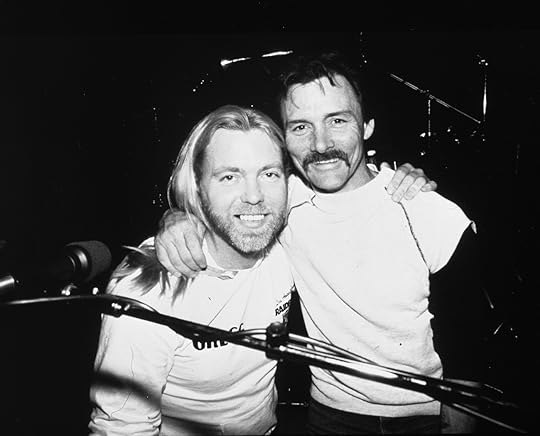
Gregg and Dickey, 1986 – by Kirk West
Well, this is cool. 07/12/86, Starwood Ampitheatre, Charlie Daniels’ Volunteer Jam. Reunion of the Allman Brothers Band
Lots of sartorial and grooming jokes that could be made, but I’d say that it’s pretty amazing that this is the first performance in years and that it would take three more years until they really reunited, with, of course, a different lineup. Cool that they have the grand piano out there for Chuck, too. Enjoy.
September 15, 2016
Gov’t Mule The Tel-Star Sessions Reviewed

Foto – Kirk West
I reviewed Gov’t Mule’s new archival release The Tel-Star Sessions in the current issue of Relix.
Kicking Asses
In 1994, a year before their self-titled debut and just two months after their first show, the original Gov’t Mule – Warren Haynes, Allen Woody and Matt Abts – entered Tel-Star Studios in Bradenton, Florida. What do the demos for one of the rawest power trio albums of recent decades sound like? Exactly how you would imagine.
The band had just come off an intensive week writing and jamming in Macon, GA’s Big House, in the very same room where the original Allman Brothers Band had rehearsed from 1970-73. They were solidifying a focused, cohesive sound, as can be heard on the newly released The Tel-Star Sessions and which anyone lucky enough to see an early Mule show can attest.
The songs – two thirds of which would appear on Gov’t Mule – are heavy but buoyed by a sense of mischievous fun. The three instruments share the spotlight, with Woody unleashing a low, fuzzy rumbling bass that’s as integral as Haynes’ guitar. It’s fascinating to hear early takes of epochal Mule songs like “Left Coast Groovies,” “Rocking Horse” and “Blind Man in the Dark” but the material stands on its own and the two songs they never cut in the studio again –Willie Dixon’s “Same Thing” and ZZ Top’s “Just Got Paid” – also sparkle with a stoner, proto-metal vision of the blues.
Haynes and Woody were fulfilling their shared vision of resurrecting the sparse, heavy freedom of classic power trios like the Jimi Hendrix Experience, Cream, Mountain and Free. Five years into helping revitalize the Allman Brothers Band, they were looking to make their own statement – to get their ya-yas out. They did exactly that, with a freedom and friskiness that can only come from serving no other masters. The Tel-Star Sessions is a vital reminder of just how audacious Gov’t Mule was at its inception.
ICYMI, a cool video of their cover of ZZ Top’s “Just Got Paid”:
September 9, 2016
9-11, 15 YEARS LATER: STILL RAW
Reposted today, as I do every year on this date. I don’t think the words will ever be any less true. The following summer I visited the Flight 93 crash sight in Shanksville, PA and paid my respects. All the same feelings…

My family strolling through 9/11 Memorial, Liberty State Park on 9/11/11
Fifteen years later, 9-11 is still very, very raw to me.
In 2011, on the tenth anniversary, my whole family visited the Statue of Liberty and we went up in the crown. The security was tight. There were helicopters flying overhead. And when we got back on the ferry to leave, I looked back at the Statue of Liberty and felt as patriotic as I ever have and I thought, “She’s still here and you’re not.”
We took a family picture and we smiled because it felt good to be alive and to be together, and to feel like our way of life had not been destroyed. But we smiled with heavy hearts, because, of course, we thought about everyone who wasn’t there, everyone we all should remember on this day every year.
We came back from the Statue and walked through the very beautiful memorial in Jersey City, in Liberty State Park. I walked through it silently, looking at the names etched on the side: husbands, wives, daughters, sons, lovers, friends who never came home. And I wept to myself.
It’s still so real.
Part of me wants 9-11 to be a National holiday but I can’t bear the thought of it becoming like Memorial or Labor Day; another excuse for sales and a cooler full of beer.
I know this was a national tragedy, but I just don’t think people outside of the NYC area felt it or understood it in quite the same way as those of us who were here in the metro area. We saw the cars sitting unclaimed in the train stations. The missing posters lovingly hand written and pasted all over the city, the candles burning in front of every fire station.
At noon on 9-11, I was at the South Mountain YMCA picking up Jacob, who was 3, and helping the director go through the files looking for kids who had two parents working in Manhattan, flagging two kids whose parents both worked in the Towers. It took hours until everything sorted itself out. One little baby girl lost her mother. A father around the corner never came home.
The next day I went up to the South Mountain Reservation, walked over to the edge of the wall on the bluff overlooking downtown New York and where the towers used to be was a big grey cloud swirling around and filling the air – even here, 25 miles away – with an acrid smell.
I want to make sure my kids understand, really understand, how real this was. How real it still is to me. So I will take them up there in a few minutes to lay some flowers at the memorial. It sprouted immediately, spontaneously, and is now official, honoring our friends and neighbors who got up and went to work and never came home.
“Never forget” means a lot of things to a lot of people. I’m thinking of them.
September 1, 2016
John Mayall to tour as trio for first time
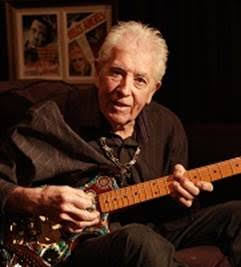 The following is a press release I thought you might enjoy. I did not write or edit. -AP
The following is a press release I thought you might enjoy. I did not write or edit. -AP
LOS ANGELES – With a new studio album titled Talk About That in the can for release in early 2017 on Forty Below Records (which includes special guest Joe Walsh on two tracks); and a lengthy US tour through late fall, British blues “Godfather” John Mayall announced today that effective with the upcoming tour dates, his band will perform as a trio. Mayall officially released the following statement today.
TO MY FAITHFUL FOLLOWERS
As many of you will have heard the dramatic news that I will now be performing live shows as a trio, I feel I should explain how it all came about in a chain of events that led to my decision. Due to severe storm conditions recently, guitarist Rocky Athas was unable to get out of Dallas for my recent festival shows that led to my performing as a trio. Having never performed anywhere or at any time without a guitar sidekick, I found that I was able to explore new territories in a trio configuration playing organ, keyboards, harmonica and guitar. Needless to say I was surprised at how different and stimulating the experience was for me as a performer.
Several days after the show I made the decision to explore this new venture. When I told Rocky of my decision, he was very understanding and hopefully his popularity in my band for the past seven years will be increased as he resumes his solo career. To me it seems fitting that the final guitar position in my band featured one of the nicest and most talented guys I’ve known and the best in his field. We all wish him well.
So now, as Greg Rzab, Jay Davenport and I embark on several weeks of intensive touring all around the States, we hope you all will enjoy the fireworks coming your way as my live show calendar brings us to your expectant ears.
Thank you everyone.
– John Mayall
September, 2016
For more information, visit www.johnmayall.com and www.fortybelowrecords.com
John Mayall US Tour Dates
9/8 Tupelo Music Hall Londonderry NH
9/9 Payomet Performing Arts Center North Truro, MA
9/10 Infinity Hall Hartford, CT
9/13 Skyline Ballroom New York, NY
9/14 Mexicali Live Teaneck, NJ
9/15 Daryl’s House Pawling, NY
9/16 Swyer Theatre – The Egg Albany, NY
9/17 Niagara Falls Blues Festival Niagara Falls, NY
9/18 State Theatre State College, PA
9/20 Artsquest Musikfest Café Bethlehem, PA
9/21 Jergel’s Rhythm Warrendale, PA
9/22 The Kent Stage Kent, OH
9/23 Notes at Copious Columbus, OH
9/24 Live at Ludlow Garage Cincinnati, OH
9/25 Buskirk-Chumley Theatre Bloomington, IN
9/27 Callahan’s Music Hall Auburn Hills, MI
9/28 Holland Park Theater Holland, MI
9/29 The Warehouse Carmel, IN
9/30 City Winery Chicago, IL
10/1 Shank Hall Milwaukee, WI
10/2 Dakota Jazz Club Minneapolis, MN
10/4 The Washington Burlington, IA
10/5 Knucklehead’s Saloon Kansas City, MO
10/7 King Biscuit Blues Festival Helena, AR
10/8 Gumbo Festival at Smith Park Jackson, MS
10/9 City Winery Atlanta, GA
10/11 King Center Melbourne, FL
10/12 Amaturo Theater Ft. Lauderdale, FL
10/13 Capitol Theater Clearwater, FL
10/14 Lyric Theatre Stuart, FL
10/15 Ponte Vedra Concert Hall Ponte Vedra, FL
11/3–11/6 Jazz Alley Seattle, WA
11/7 Aladdin Theater Portland, OR
11/9 Tower Theatre Bend, OR
11/10 El Rey Theatre Albuquerque, NM
11/11 Rio Theater Santa Cruz, CA
11/12-11/13 Yoshi’s Oakland, CA
11/14 Tower Theatre for Performing Arts Fresno, CA
11/15 Crest Theater Sacramento, CA
11/16 Fremont Theater San Luis Obispo, CA
11/17 Canyon Club Agoura Hills, CA
11/18 The Rose Pasadena, CA
11/19 The Coach House San Juan Capistrano, CA
11/20 Belly Up Tavern Solana Beach, CA
August 30, 2016
Gov’t Mule – Just Got Paid video

The Mule. Macon, 1996. Awesome photo by Kirk West
Gov’t Mule recently releases a new archival album, The Tel-Star Sessions. The album features songs taken from the group’s June 1994 demo sessions at Tel-Star Studios in Bradenton, FL.
The sessions with Allman Brothers Band sound man Bud Snyder feature the original lineup of Haynes, Allen Woody and Matt Abts. They were intended to be the Mule’s debut album, but the recordings were never released until now. You can The Tel-Star Sessions by clicking this link. One tune on the album is a cover of ZZ Top’s “Just Got Paid.” Check out the new video for this old song. Cool stuff.
August 27, 2016
RIP Stevie Ray Vaughan – the story of his final gig
SRV has played a large role throughout my career. Though I never interviewed him because he passed away before I started working for Guitar World, I have written many, many articles about Stevie, including a massive oral history which led me to interview almost everyone involved with his music. Without that, I might never have chosen a similar format for One Way Out: The Inside History of the Allman Brothers Band.
I was in Austin for the tribute concert brother Jimmie threw, there for two days of rehearsal, which led to me writing this piece for the New Yorker.
I was down there reporting for Guitar World, and my piece on the event was one of the most heartfelt I’ve ever written, and it led to me writing the liner notes for the resulting CD and DVD releases and eventually, also writing an extensive essay for the SRV box set. And that made a Chinese guitarist named Woodie Wu want to meet me, which led to the formation of Woodie Alan, which eventually led to Big in China. That’s a lot of condensing, but it gives you a hint of why Stevie Ray Vaughan has meant so much to me – aside from great musical legacy, which needs little elaboration.
I still feel emotional reading this piece. RIP SRV and thanks for the music.
Originally printed in Guitar World, November 2008
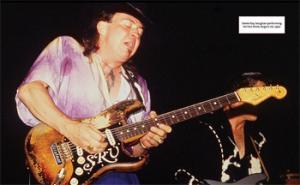 August 26, 1990 – East Troy, Wisconsin
August 26, 1990 – East Troy, Wisconsin
Stevie Ray Vaughan was right where he wanted to be as midnight approached on August 26, 1990. Earlier that evening, he had closed out a triumphant summer tour with Double Trouble, opening for Eric Clapton, one of his heroes, in front of a sold-out crowd of 30,000 at the Alpine Valley Music Theatre, just outside of East Troy, Wisconsin.
Now, as Clapton’s show was drawing to a close, the guitarist called Vaughan back out for a final encore performance of the blues standard “Sweet Home Chicago.” Joining them onstage was the night’s first performer, Robert Cray, along with two more of SRV’s heroes: Buddy Guy and big brother Jimmie Vaughan. Stevie Ray was all smiles as the five guitarists took turns soloing throughout the lengthy jam.
Almost four years after cleaning up and leaving alcohol behind, the Texas guitarist was on top of his game. Family Style, his new album with Jimmie, was in the can, due to be released in another month. The feuds that had separated the brothers were long buried. The show was the second of a two-night stand, and Stevie’s playing was, by all accounts, fiery and fresh. With his favorite guitarists surrounding him, it must have felt to him like the exclamation point on a fantastically productive and happy period of his musical life.
“Those shows were just great fun, really exciting,” recalls bassist Tommy Shannon. “They were sort of the culmination of all the good times we’d been having for the last year or two. And as good as we had been playing, those two shows were just unreal.”
Adds Jimmie Vaughan, “Stevie just smoked. It was one of those gigs where you see someone play and you can’t believe what you’re hearing. Stevie was unreal. He was just on another plane, and we all knew it.”
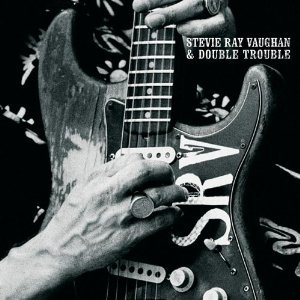 When the final jam finished to an ecstatic roar at about 12:15 A.M., the musicians left the stage through a rear exit. Backstage, Clapton and Vaughan reportedly talked about paying tribute to Jimi Hendrix with some future gigs. Stevie, 35, was supposed to drive back to Chicago with Jimmie and Jimmie’s wife, Connie, but then he heard that he could hop onto one of Clapton’s four waiting helicopters. He initially thought all three of them could hitch this ride. When he learned that there was only one spot, he asked Jimmie and Connie if they minded if he grabbed it.
When the final jam finished to an ecstatic roar at about 12:15 A.M., the musicians left the stage through a rear exit. Backstage, Clapton and Vaughan reportedly talked about paying tribute to Jimi Hendrix with some future gigs. Stevie, 35, was supposed to drive back to Chicago with Jimmie and Jimmie’s wife, Connie, but then he heard that he could hop onto one of Clapton’s four waiting helicopters. He initially thought all three of them could hitch this ride. When he learned that there was only one spot, he asked Jimmie and Connie if they minded if he grabbed it.
“I really want to get back,” he explained.
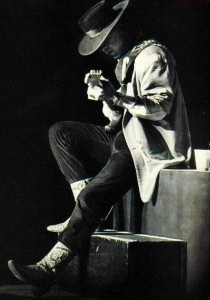 The Bell 206 B helicopter took off in fog around 12:40 A.M. with Vaughan and four others aboard and almost immediately slammed into the middle of a nearby man-made ski slope, killing all aboard. They were just over half a mile from the venue but no one heard the crash, and a search for the wreckage wasn’t begun until 5 A.M. At around 7, searchers found the bodies of Vaughan, pilot Jeff Brown and three of Clapton’s associates.
The Bell 206 B helicopter took off in fog around 12:40 A.M. with Vaughan and four others aboard and almost immediately slammed into the middle of a nearby man-made ski slope, killing all aboard. They were just over half a mile from the venue but no one heard the crash, and a search for the wreckage wasn’t begun until 5 A.M. At around 7, searchers found the bodies of Vaughan, pilot Jeff Brown and three of Clapton’s associates.
“I was woken up by a phone call from our tour manager saying that we had to have a meeting in my room right away,” Shannon recalls. “A few minutes later I got a call from our manager, saying that one of the helicopters had gone down, Stevie was on it, and there were no survivors. In the blink of any eye my life was taken away from me.”
Double Trouble drummer Chris Layton got the news from Shannon. Says Shannon, “I was sitting on the bed crying, and Chris came into my room, asking what was going on. I said, ‘Stevie’s dead,’ and he just lost it, too.”
Adds Layton, “I was in denial and didn’t believe it at all, so I called security and forced them to let me into Stevie’s room. I really thought he’d be laying there sleeping, but when they opened the door, the bed was still made, the pillow turned down, with mints laying on it, and I just realized, My God, it’s true. I felt like a baby, just completely helpless. Then we realized that the news reports said that Stevie and his band were killed, and I realized that I had to get a hold of family and tell them that I’m still alive.”
Clapton and Jimmie Vaughan were called and asked to identify the bodies. Over 1,500 people attended SRV’s memorial service in Dallas. He is buried at Laurel Land Memorial Park in South Dallas.
August 26, 2016
The Recording of Layla and Other Assorted Love Songs
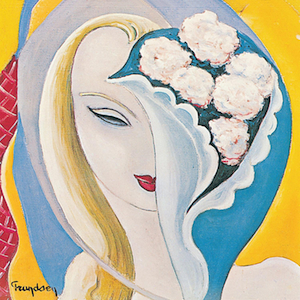 This week in 1970, Eric Clapton and Duane Allman and the rest of Derek and the Dominos recorded Layla And Other Assorted Love Songs
This week in 1970, Eric Clapton and Duane Allman and the rest of Derek and the Dominos recorded Layla And Other Assorted Love Songs in Miami. Here’s the story of that landmark album, in an excerpt from One Way Out: The Inside History of the Allman Brothers Band. Copyright 2014 – Alan Paul.
in Miami. Here’s the story of that landmark album, in an excerpt from One Way Out: The Inside History of the Allman Brothers Band. Copyright 2014 – Alan Paul.
**
With their second album done, the band returned to the road. One of Dowd’s next clients was a hero of Dickey and Duane’s – Eric Clapton, recording with his new band of American musicians poached from his friends Delaney and Bonnie. Soon to be known as Derek and the Dominos, the band came to Miami to record their debut album, with just a few songs written.
TOM DOWD: When I was working with the Allman Brothers on Idlewild South  , I got a call from [Clapton manager] Robert Stigwood saying that Eric would like to record and asking if I could fit him in my schedule. Of course I said I’d be delighted. It became a lengthy conversation, which I normally would never have while I was working with someone. I put the phone down and apologized, saying to Duane, “You have to excuse me. That was Eric Clapton’s manager. They want to come here and record.”
, I got a call from [Clapton manager] Robert Stigwood saying that Eric would like to record and asking if I could fit him in my schedule. Of course I said I’d be delighted. It became a lengthy conversation, which I normally would never have while I was working with someone. I put the phone down and apologized, saying to Duane, “You have to excuse me. That was Eric Clapton’s manager. They want to come here and record.”
He said, “You mean this guy?” and plays me an Eric solo note for note. I said, “That’s the one,” and he goes, “I got to meet that guy. Let me know when he’s gonna be here. I’d love to come by and watch. Do you think that would be possible?” And I told him I was sure it would be fine, he should call me and we’d work it out.
ERIC CLAPTON: I was very aware of Duane. I had become aware of him when I heard Wilson Pickett’s “Hey Jude.” That break at the end just blew me away and I immediately made a call to Atlantic Records to find out who it was. It was one of the few times in my life where I had to know who that was — now!
We went to Miami just to record with Tom Dowd. It’s where he was based, and he was raving about the studio and the musicians we could get if we needed anyone extra. Duane hadn’t even been talked about at that point. That was much more coincidental.
DOWD: I was recording with Derek and the Dominos [at Criteria, on August 26, 1970], and Duane calls: “Is he there? We’re gonna be in Miami tomorrow for a concert. Can I come meet him?’” I said, “I’m sure you can. Hold on.”
I grabbed Eric and said, “I have Duane Allman on the phone. His band is playing in the area tomorrow and he’d like to come meet you.” And he goes, “You mean this guy?” And he plays Duane’s solo off of Wilson Pickett’s “Hey Jude”’ note for note. I said, “That’s the guy.” And he goes, “I’ve got to see him perform. We’re going to that concert.”
CLAPTON: When I heard they were playing nearby after we had been in the studio about a month, I immediately wanted to go.
DOWD: Now I knew the two of them personally and they were both low-key, beautiful human beings and wonderful musicians, so I thought, “This is gonna be fun.” Sure enough, Saturday afternoon, we record for a few hours, and then head out to the limos Eric had waiting and go down to the Convention Center, where the Allman Brothers are playing. They snuck us in behind the photographer’s barricade, sitting on the floor with our backs to the audience, right in front of the stage. Duane’s in the middle of a solo, when he opens his eyes, looks down, sees Eric and stops playing cold, in shock. Dickey starts playing to cover until Duane regains his equilibrium, and then he sees Eric and he freezes too. That’s how big Eric was to them.
BOBBY WHITLOCK, Derek and the Dominos keyboardist: They were playing on a flatbed behind an 18-wheeler that had hay bales around the front to keep the crowd back and we crowded up under the trailer and put our backs to the bales and were sitting there looking up at them. Duane was wearing it out and he looked down and saw us – saw Eric looking at him – and he just stopped playing. He always had his mouth open when he was getting down on it, but he didn’t close it this time. Then Dickey was wondering what was going on and looked down and stopped playing, and I thought the whole band would stop, but they kept cranking and then the guitarists got back on it.
DOWD: After the show they met and hung out and all of a sudden I had half the Allman Brothers and all of Derek and the Dominos crammed into a limousine going back to Criteria, where they jammed until two or three the next afternoon. I kept the tape running the whole time. There’s Duane playing Eric’s guitar and Gregg playing Bobby Whitlock’s organ and they were all in piggy heaven.
JAIMOE: Everyone was really grooving, but I wasn’t all that knocked out by what Clapton was doing, or the whole scene, so I went out to the Winnebago, smoked some pot and listened to Tony Williams’Emergency!
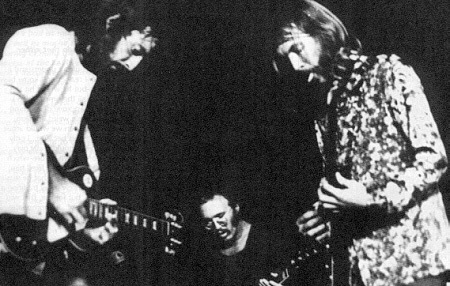
Duane Allman played two shows with D&D. This was at Curtis Hixon Hall in Tampa, FL.
Many of these impromptu performances were eventually released on The Layla Sessions: 20th Anniversary Edition, which included five jams totaling over 70 minutes.
CLAPTON: Needless to say, Duane and me hit if off instantly — soul mates, instant soul mates.
WHITLOCK: This thing with Eric and Duane was such a natural. They had the same authority, and they dug from the same well: Robert Johnson, Elmore James, Sonny Boy Williamson, Bill Broonzy. Of course, I already knew Duane from working together with Delaney and Bonnie, so I wasn’t surprised at all that they hit it off.
ALLMAN: That was a lot of fun and a lot of good music went down that night. I was glad to be there, man.
WHITLOCK: Of course we had some drinks and other recreational relaxants and were just enjoying each other’s company. But something deeper was happening right away with Eric and Duane, who were like two long-lost brothers. Those two guys started bouncing back and forth on each other and it was an amazing experience. Everyone else drifted away eventually, but Duane stayed all night.
DOWD: When it was over, they were all such good friends, then Eric said to Duane, “When are you coming back? We should record some.”
CLAPTON: I just asked him if he’d like to come into the studio and play and help me out.
DOWD: The Brothers had to go back on the road, but Duane said he’d be back as soon as he could and a few days later he called and said, “I’ll be there tomorrow.”
DOUCETTE: Wexler called Phil and asked Duane to come back to Miami and I got into that Ford van and drove down with him. When we arrived we had about 14 dollars, half a joint and a wee bit of a wine. Wexler goes, “You need anything?” I said, “We’re broke, man, tapped.” he reached into his pocket and pulled out a handful of hundreds and hands them to Duane, who eyeballed it and handed me about half.
This is close to midnight. He walks in there with his amp in one hand and his guitar in the other and all the guys are sitting around and they go, “Well, tomorrow we’re going to get busy.” And Duane goes “Tomorrow? I just drove 15 hours in that piece of shit. Let’s play some music.” He plugged in and tuned up and everyone started getting up and going to their instruments.
WHITLOCK: He came and joined us at the Thunderbird Motel. He got a room right next to mine. One of the most amazing things I ever witnessed was in Eric’s room there. The two of them were going back and forth hitting a Robert Johnson lick, then Elmore James and on and on. I knew I was witnessing something real special – these guys in front of me pulling all this from the deep well. I was in awe, because they were both in their early 20s and they were like two 70-something old blues guys from the fields of Mississippi running it down.
DOWD: By then, the Dominos had recorded several songs and had arrangements set for others, but right away Duane started fitting in parts and the more he did that, the more songs started to radically change. Duane had unleashed this dynamic entity that was just ridiculous. They were feeding off each other like crazy and running on pure emotion.
WHITLOCK: We weren’t really stagnant before Duane arrived. “I Looked Away,” “Tell the Truth” and “Bell Bottom Blues” had been written and recorded. We had come up with “Keep on Growing” in a jam. Eric kept Playing guitar parts and I ran out into the lobby with a yellow pad and wrote out the lyrics as fast as my fingers would move. So we had something, but we didn’t have enough material for one album, much less a double album. We didn’t have a plan and when Duane came on the scene, everything exploded and things just started coming.

Duane photo by Twiggs Lyndon.
DOWD: I’ve never seen spontaneous inspiration happen at that rate and level. One of them would play something, and the other reacted instantaneously. Never once did either of them have to say, “Could you play that again, please?” It was like two hands in a glove. And they got tremendously off on playing with each other. That whole album is definitely equal parts Eric and Duane. The whole session was just so damn impromptu and fly-by-the-seat-of-your-pants brilliant. It was just a wonderful experience to witness such meshing of musical minds, such telepathic sympathies.
WHITLOCK: We had two leaders then. We had Eric and Duane. Eric backed up and gave Duane a lot of latitude, a lot of room, so he could contribute up to his full potentiality, and Duane was full of fire and ideas. He’d just go, “Hey, how about we try ‘Little Wing?’” – that was completely his idea and he came up with the intro by himself. He just started playing it.
Duane was very, very good in the studio. Working with the finest musicians and engineers on the planet really paid off for him. When he had the opportunity to be thrust into that environment, he absorbed what was right and righteous and then used it to killer advantage.
DOWD: It was never gonna happen again; if you didn’t catch it, you blew it, so I had the tape rolling constantly. The spontaneity of that whole session was absolutely frightening.
WHITLOCK: Sam the Sham [Domingo “Sam” Zamudio of “Wooly Bully” fame] was in studio B recording. I knew him from my childhood days and he suggested that we do “Nobody Knows You’re Down and Out” and “Key to the Highway.” Those were his ideas.
During the Layla sessions, Duane also found time to join Zamudio to record three songs: “Me and Bobby McGee,” “Relativity” and “Goin’ Upstairs,” all of which can be heard on Skydog: The Duane Allman Retrospective.
WHITLOCK: We were just jamming and it turned into “Key to the Highway.” The reason that song fades in is Tom Dowd was in the toilet and it was one of the few times during these sessions that tapes weren’t rolling. He came running out of the can, screaming, “Push up the faders! Push up the faders!”
DOWD: There have been a lot of stories about how much drugs these guys did, but we started sessions every day at 2:00 and everyone arrived clear eyed and ready to work. As I dismissed people, they may have floated away, but it did not interfere with the album. Even in his wildest moments, Eric arrived at the studio on time with his instrument in tune, ready to play — and he would give absolute hell to anyone who didn’t. Eric and Duane shared that. They didn’t know each other from Adam before the sessions began, but they were both taskmasters. They didn’t give a damn what anyone did on their own time, but when they were in the studio, it was their time, and you better be ready to go.
Excerpted from One Way Out: The Inside History of the Allman Brothers Band. Copyright 2014 – Alan Paul.
August 24, 2016
Remembering Brian Farmer, gone two years
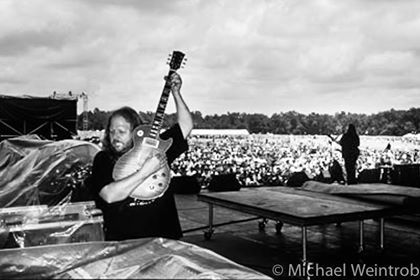
This photo by Michael Weintrob says it all. Farmer working so Warren could do his thing without ever thinking twice about anything gear related.
I am re-upping this today, marking two years since Farmer’s death. I am very proud that I own his Strat. Miss this guy very much. Very few crew members have ever had such a deep impact.
*
Warren Haynes’ longtime and much beloved guitar tech Brian Farmer died Sunday August 24, at his home near Nashville. Farmer died peacefully in his sleep. He was 53.
“He was a close friend, a devoted worker, and a lover of life,” says Haynes. “We traveled around the world together and shared many experiences-mostly while laughing. He will be missed by a huge circle of friends and family.”
Brian Farmer was extraordinarily dedicated to his craft, to the world of guitars and amps, to Warren and all his projects – and to the music itself. People like Brian keep the wheels turning and the gears greased and the guitars in tune. The shows don’t happen without them – and no one did any of this better, with more dedication, heart and soul than Farmer.
Farmer began working for Gov’t Mule in 1998, brought to the band by his old friend, bassist Allen Woody, who died almost exactly 14 years earlier. Prior to joining the Mule crew, Farmer worked for Johnny Cash for eight years before the Man in Black retired from touring. Farmer was exceedingly proud of his close relationship with Johnny and June Carter Cash.
“When Johnny retired, I ran into Allen and said, ‘You need to hire me, you need to hire me,’ Farmer told Hittin the Note magazine.
Months later, Gov’t Mule needed a guitar tech and Woody called his old friend. In the subsequent years, Farmer became an indispensable part of the operation, teching Warren Haynes’ guitars and also serving as the band’s equipment manager and stage manager.
Farmer has been by Haynes’ side for every gig the busy guitarist has played since 1998 – with Gov’t Mule, the Allman Brothers Band, the Warren Haynes Band, the Dead, Phil and Friends and others.
Farmer and Haynes developed an extremely close working relationship.
“We have looks that we give each other,” Farmer told Hittin the Note. “An eyebrow, a flick of the wrist… a shrug of his shoulders …I’ve learned to listen for things. I can tell sometimes when he’s close to breaking a string. With the Mule, I sometimes come out to adjust his amplifier before during and after songs.”
“He was one of a kind,” says Haynes. “He lived and breathed his job. He knew a lot more about guitars and gear than I did so I could trust him to keep things working in a technical manner so I could concentrate on the music.”

Farmer at Wake Up With Warren, Peach Fest 2014 – Sunday, August 17. Photo by Derek McCabe.
Says Allman Brothers Band manager Bert Holman, ”Brian was a very dedicated, very loyal, very skilled technician. He was from the old school and would help anybody and everybody do their job. If something of Derek or Gregg’s blew up, he’d be the first guy to grab a flashlight or tool and run across the stage because he was a team player. His standard line to any request was, ‘Just tell me what you need.’ Brian always had your back. He was kind to the fans and tried to give them as much time as he could without taking his eyes off the ball, which he never, ever did.”
Farmer also had a very close relationship with the Gibson Custom Shop, working with them on all of Haynes’ custom guitars.
“Brian was more than a visitor to Gibson Custom,” says Rick Gembar, Gibson Senior Vice President and General Manager of the Custom Division. “We were blessed to get to know him over the years as he came and went on behalf of Warren. During those years, he built relationships with everyone, from the front desk to the craftspeople, to me personally. He was a friend, well respected as a technician and genuinely admired for his kindness as much as for his tireless work ethic and attention to detail. Seeing him come through the door was always a welcome sight to the people here.
On behalf of everyone here at Gibson Custom, I send our deepest condolences to his family, Warren, Brian’s friends and all others that he touched during his time.”
Farmer’s death was greeted with shock and grief across the internet by fans and musicians alike. It is hard to imagine many other rock and roll road crew members who were more respected and beloved. Among those expressing their sorrow and respect on Twitter were Phil Lesh – “Fare thee well, Farmer – I love you more than can words can tell” and Derek Trucks.
The latter summed things up beautifully in a series of #ThankYouFarmer tweets: “People like Brian Farmer are the backbone of all live music. Without the hard work of folks like Farmer we’d be lost.”
August 22, 2016
Bob Weir has a new solo album coming. It’s called Blue M...
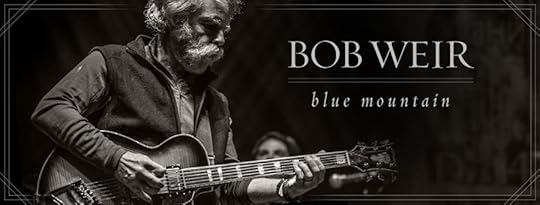
Bob Weir has a new solo album coming. It’s called Blue Mountain and I’ve been hearing very good things about it. Here’s a first taste, the single “Only A River.”
and I’ve been hearing very good things about it. Here’s a first taste, the single “Only A River.”
You can preorder the album on Amazon right here.
From the video post:
Before he co-founded the Grateful Dead, Bob Weir spent a summer working and living on a ranch in Wyoming, sparking a lifelong fascination with the stories and songs of the American West. Blue Mountain, Weir’s first solo album in over 10 years, brings his musical journey full circle. Working with producer Josh Kaufman, acclaimed songwriter Josh Ritter, guitarists Aaron and Bryce Dessner and bassist Scott Devendorf, Blue Mountain is a moody, highly textured modern interpretation of Weir’s unforgettable experience.
Visit the official Bob Weir website: http://bobweir.net/
August 20, 2016
Phil Lynott, 1949 – 1986
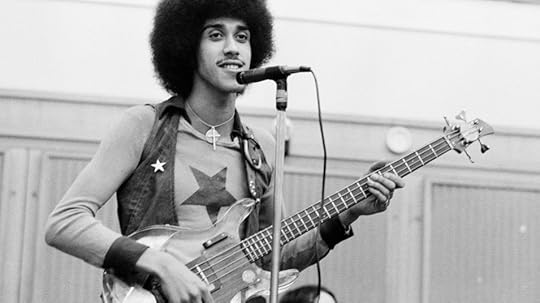 Phil Lynott formed Thin Lizzy in 1970 when he was 21. Though he had only just learned to play bass, the Dublin, Ireland band recorded their self-titled debut album within a year. They released six more albums over the following five years, gaining moderate success in Ireland and England as Lynott honed his songwriting. In 1976, the band recorded their masterpiece, Jailbreak, which included the breakthrough hit, “The Boys Are Back In Town,” a catchy but hard-rocking ode to blue collar buds.
Phil Lynott formed Thin Lizzy in 1970 when he was 21. Though he had only just learned to play bass, the Dublin, Ireland band recorded their self-titled debut album within a year. They released six more albums over the following five years, gaining moderate success in Ireland and England as Lynott honed his songwriting. In 1976, the band recorded their masterpiece, Jailbreak, which included the breakthrough hit, “The Boys Are Back In Town,” a catchy but hard-rocking ode to blue collar buds.
Thin Lizzy furthered their strong live reputation with a host of hot guitarists shuffling in and out of the lineup, teaming with Scott Gorham to engage in melodic dual leads. Gary Moore, Snowy White and John Sykes were amongst the guitarists in the parade. But as hot as their playing was, Lynott remained the band’s heart and soul.
The son of a working-class Irish mother and a black South American father, Lynott’s tunes combined the working class heroes of Bruce Springsteen and Bob Dylan with a hard-hitting yet melodic crunch. Lynott was also an early and loud supporter of punk rock. In 1978, he formed a side group, The Greedy Bastards, with Rat Scabies of the Damned.
Plagued by infighting and Lynott’s worsening drug problems, Thin Lizzy disbanded in 1983 and the former leader released several solo records and published a now-out-of-print book of poetry while continuing to struggle with his demons. Following a drug overdose, Lynott was found unconscious in his London house and died of heart failure and pneumonia on January 4th, 1986. He is buried in Saint Fintan’s Cemetery, in Dublin. The Gaelic inscription on his stone translates to, “May God give peace to his soul.”
–



